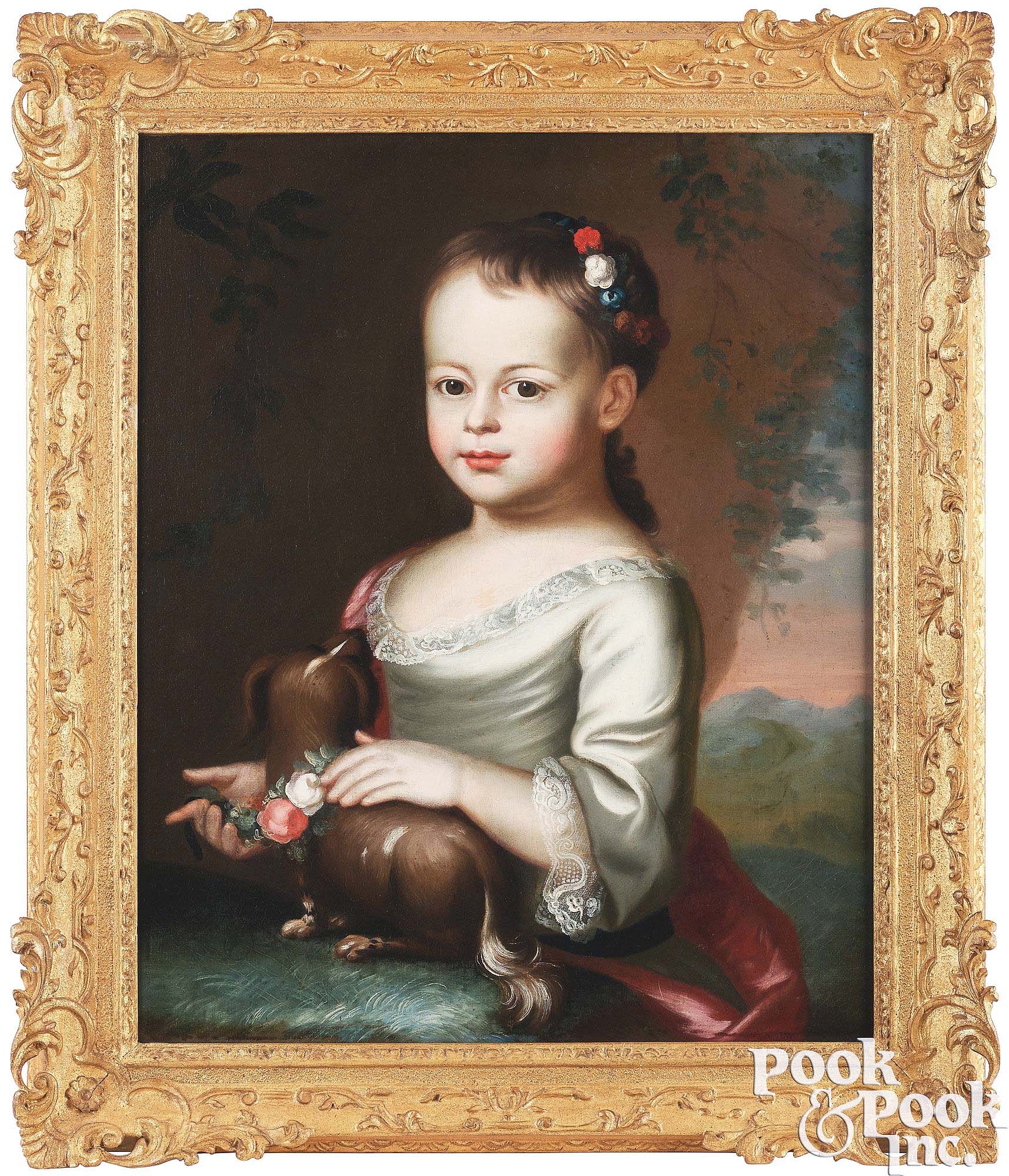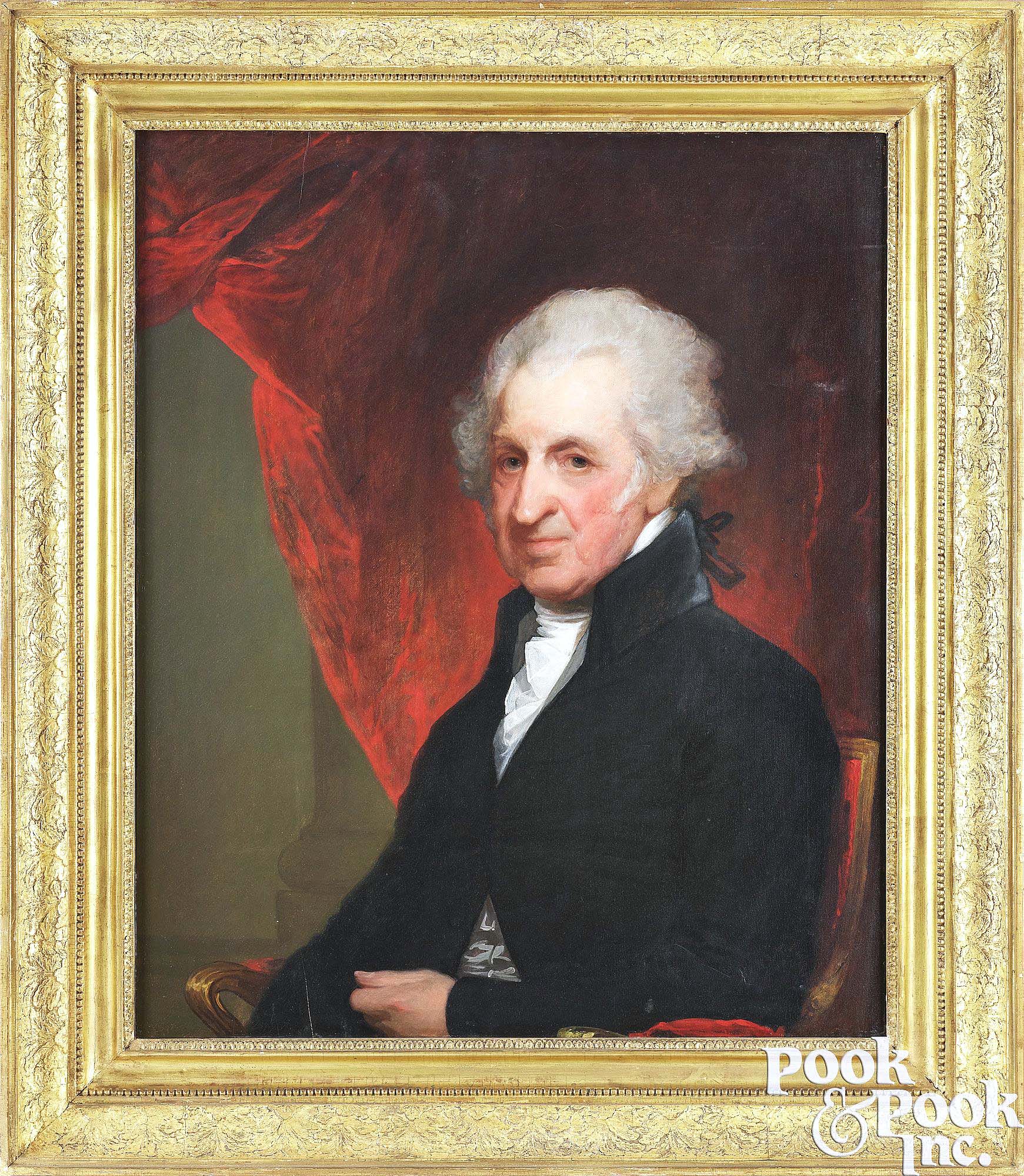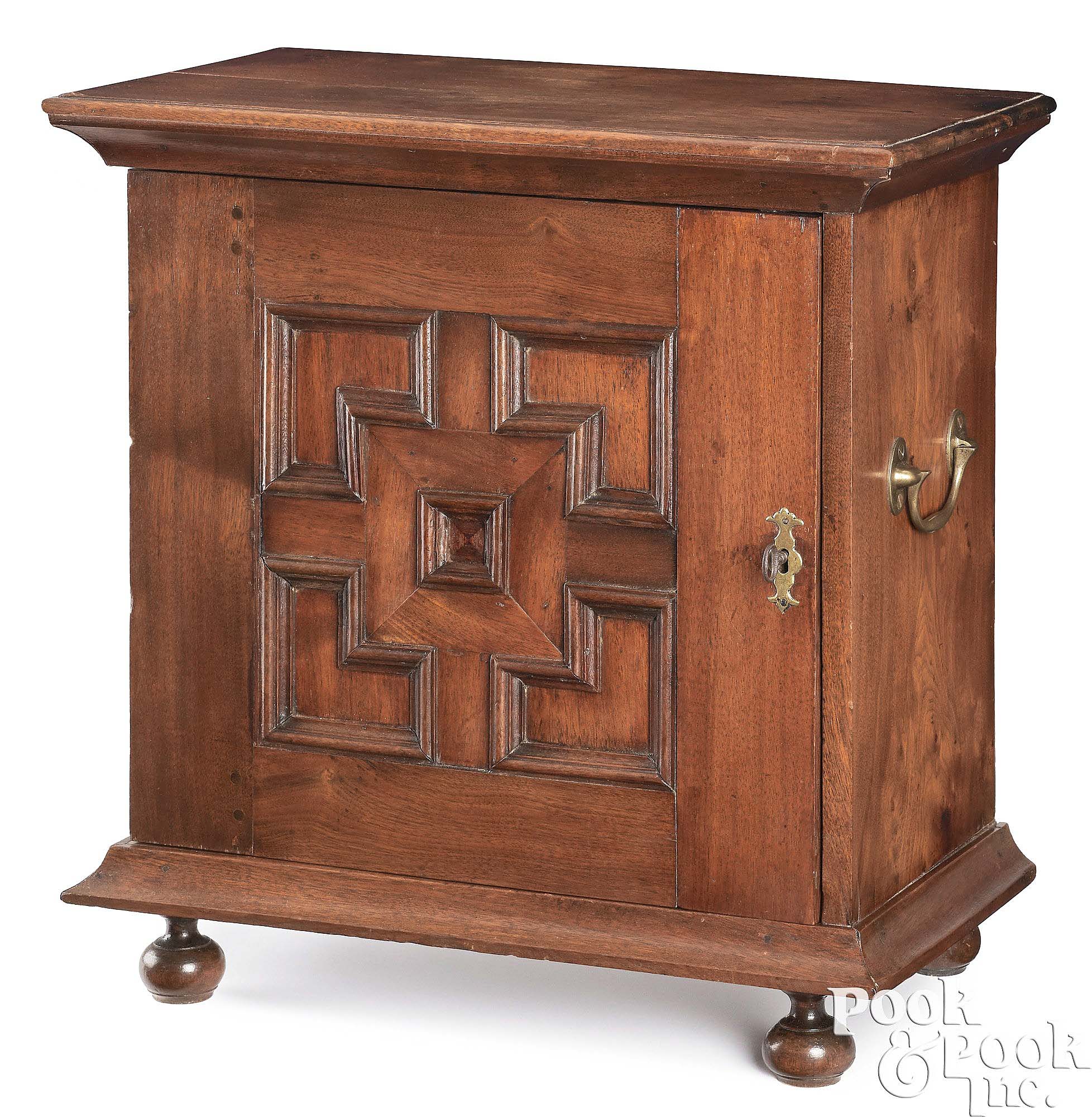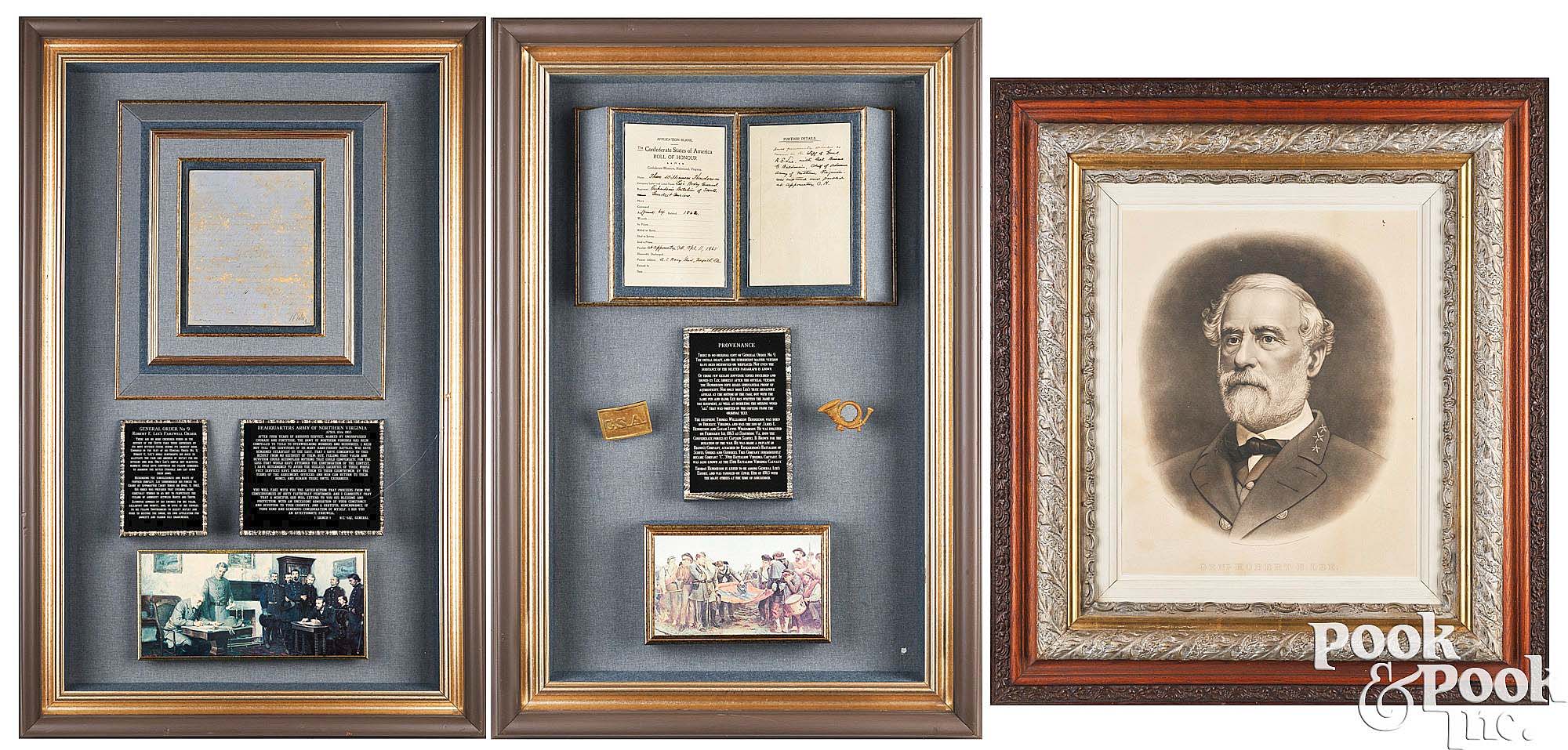
Achieving the highest price was this oil on canvas portrait of young Priscilla Greenleaf by John Singleton Copley (American, 1738-1815), 26-7/8 by 22-7/8 inches framed. After 44 bids, it sold for $500,000 — well above its $60/80,000 estimate.
Review by Carly Timpson
DOWNINGTOWN, PENN. — Pook & Pook’s two-day Americana auction, January 16-17, closed with 97 percent of the 981 lots offered successfully changing hands for a total realized of $3,167,286 — nearly $1 million over the high estimate, thanks in part to the exceptional result of a John Singleton Copley portrait of young Priscilla Greenleaf. Deirdre Pook Magarelli, president, noted that there were 1,907 bidders active across all platforms, including online, phone, absentee and with around 25 live in the saleroom on each day.
The portrait of Priscilla Greenleaf, along with the artist’s paintings of her two siblings that are now in the collection of the Metropolitan Museum of Art, “rank among the most noteworthy of Copley’s early work,” according to the auction catalog. The circa 1756-58 oil on canvas portrait depicted the girl holding a small dog, had recent provenance to the Herdeg estate and bore labels from the Los Angeles County Museum of Art; Museum of Fine Arts, Boston; and Hirschl & Adler Galleries, New York City. Magarelli said “It took 44 bids to get to the final bid; there were two absentee bidders and four phone bidders.” After the intense round of bidding, Priscilla was won for $500,000, far greater than her $60/80,000 estimate.
Other portraits making their way to top prices included one of Dr James Lloyd, “an honored patriot, who treated the people of Boston during the Revolutionary War, often without pay.” Painted by Gilbert Stuart, this oil on canvas of the doctor was exhibited at the Boston Athenaeum in 1829, illustrated in several titles, including The Stories They Tell by John A. and Judith C. Herdeg (Boston: Newbury Street Press, 2021), and had provenance to the sitter and his family as well as the Herdeg estate. Housed in a period frame, it sold for more than four and a half times its high estimate, achieving $68,750.

Dr James Lloyd (1728-1810) was depicted in this circa 1808 portrait by Gilbert Stuart (American 1755-1828). The oil on canvas laid on panel measured 41-3/8 by 35½ inches framed and was bid to $68,750 ($10/15,000).
Depicting Elizabeth Bill Henshaw (1712-1782), the daughter of a wealthy Boston colonist, Richard Bill, a circa 1730-33 portrait by The Pollard Limner, in its original frame, was bid to $27,500. According to the catalog, portraits by this artist are quite rare, with only about 20 known to date, all are identified on the basis of a 1721 portrait of Anne Pollard. This painting descended through the Bill and Henshaw families, had provenance to the Herdeg estate and was included in The Stories They Tell. It was accompanied by documents detailing its provenance, research and restoration.
John Smibert’s portrait of Sarah Hall, the daughter of Hugh Hall, a Boston-based slave trader, made $22,500, stunning its $4,000 high estimate. This portrait was identified in the artist’s notebook in September of 1730 and was illustrated in The Stories They Tell. Its provenance listed Jonathan Trace, Philadelphia Antiques Show, April 2004, and the Herdeg estate.
Titled “An East Prospect Of The City Of Philadelphia; taken by George Heap from the Jersey Shore, under the Direction of Nicholas Skull Surveyor General of the Province of Pennsylvania,” a large panoramic engraving of the Philadelphia seaport and skyline was bid to $212,500, the sale’s second-highest price. The engraving was done in 1754 by Gerard Vandergucht on four large folio sheets of laid paper. The catalog provided some historical background on this engraving, noting that Thomas Penn commissioned Heap and Scull to create this image in effort to attract settlers and commerce to the city. “This Heap-Scull engraving stands as the largest and most artistically important view of any American city of the period. Due to the size of the engraving, there are very few known to have survived to the present day.” Only eight copies are held in institutional collections, including Colonial Williamsburg, the Historical Society of Pennsylvania and Winterthur.

This 84-inch-long “Prospect of the City of Philadelphia” by George Heap and Nicholas Scull, panoramic engraving by Gerard Vandergucht (1696-1766), London, 1754, on four 25¼-inch-high folio sheets of laid paper, displayed a $212,500 result ($200/300,000).
Philadelphia was further represented by a mahogany sideboard or mixing table, made circa 1755. This Chippendale-style piece had a later added, but period, King of Prussia marble inset top and shell-carved apron and knees. The table, which was hotly bid to $118,750 — well beyond its $15/20,000 estimate — is similar to examples in the collection of the Museum of Fine Arts, Boston, and in the Diplomatic Reception Rooms in Washington, DC.
An unusual form pewter teapot by Philadelphia maker William Will more than doubled its high estimate to achieve $27,500. It was illustrated in several titles including Charles Montgomery’s American Art 1750-1800 Towards Independence (Boston: New York Graphic Society, 1976) and American and British Pewter: An Historical Survey by John Carl Thomas (New York: Main Street Books, 1972). The teapot had provenance to Dr Robert Mallory of Rye, N.Y., as well as Dr Melvyn & Bette Wolf of Flint, Mich.
Also hailing from Philadelphia was a painted poplar dower chest. Front and center on the vibrant chest was a medallion with an inscription that read “Jorg Breining 1776.” According to the catalog, German-born Gerorg/Jorg Breinig (1733-1812) was one of the judges of election for the delegates of the first constitutional convention in Philadelphia and a colonel in the Revolutionary War. His dower chest, which was featured in Monroe H. Fabian’s The Pennsylvania-German Decorated Chest (New York: Universe Books/Main Street Press, 1978), had provenance to David Pottinger, James and Nancy Glazer Antiques and a private Pennsylvania collection. It was won for $23,750.
An early Philadelphia spice chest with an unusual geometric panel door went out for $22,500. The circa 1700 William and Mary chest was fitted with 12 drawers and was in excellent original condition with its original turned bun feet.

With a rare geometric molded panel door, this circa 1700 Philadelphia William and Mary spice chest measured 19¼ by 15¾ inches and went out at $22,500 ($20/30,000).
Signed mementos from notable figures found great success. One such example was a letter, written by Thomas Jefferson as Secretary of State, to the director of the US Mint, David Rittenhouse. Dated March 21, 1793, this letter was framed with a later handwritten identification note. Collectors were enticed and the letter shot past its $5,000 estimate to earn $40,000.
Another signed piece, this one in General Robert E. Lee’s hand, went for $55,000. Lee’s signed Farewell Address General Order #9 was dated April 10, 1865, the day after he surrendered to Ulysses S. Grant. The document, which was presented to Thomas Williams Henderson, a member of the 13th Virginia Cavalry and Lee’s escort and bodyguard at Appomattox, Va., was framed with a plaque and image of the signing. This collection was sold with other related items, including a framed suite of Henderson’s Confederate Roll of Honour application and a framed lithograph of the General. The collection had provenance to Bruce Gimelson, Gary Hendershott and a distinguished Southern collector.

Included in this suite, which sold for $55,000, was General Robert E. Lee’s signed Farewell Address General Order #9, dated April 10, 1865, and a memento reading “The Confederate States of America Roll of Honour,” along with a Bradley & Company lithograph portrait of General Robert E. Lee ($50/70,000).
Other Civil War items, especially flags, found success as well. The three most notable flags in the sale included the last Confederate Civil War flag to fly over the capitol in Columbia, S.C. ($35,000), the United States Marine flag flown from the Fort Walker ($30,000) and the Confederate Civil War flag captured at Fort Walker that was then replaced by the aforementioned Marine flag ($27,500). Antique Americian flag dealer Jeff R. Bridgman bought both of the Confederate flags. All three flags were cataloged with their known historical background and provenance, which can be read on Pook & Pook’s website.
Founder Ron Pook said, “This was an incredibly strong sale. Good things brought very good prices — the flags did well, the portraits did well, the pewter did well, etc. We were really happy with the results and look forward to an exciting year.”
Up next for Pook & Pook is its two-day Online-Only Decorative Arts auction on February 19-20, and they will be selling Americana again on May 1-2.
Prices quoted include the buyer’s premium as reported by the auction house. For information, www.pookandpook.com or 610-269-4040.




















